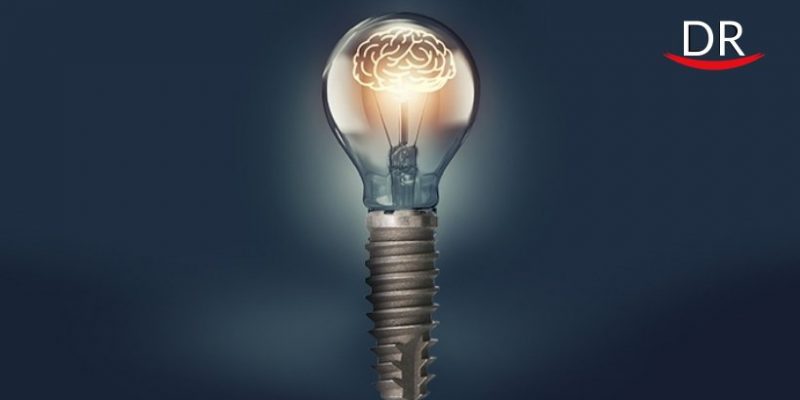Introduction
Implant treatment is one of the more successful treatment modalities in medical sciences as of today, with a survival rate of 95% in most published long-term studies. Conventional socket prostheses like obturators fail to carry enough sensory information to restore the necessary natural feedback pathways for motor function. Comparable observations can be made from the extracted teeth. The mechanoreceptive properties of the Periodontal Ligament (PDL) are very well defined by an intimate contact between collagen fibres and Ruffini-like endings. The role of periodontal neural feedback is well understood.
When osseointegrated dental implants are mechanically loaded, a sensory action, often referred to as osseoperception, is evoked. The sensory signals induced by this phenomenon are qualitatively different from the signals evoked in a natural tooth when loaded. Clinical observations on patients with osseointegrated dental implants have confirmed a special type of sensory perception skill.
The term “osseoperception” was coined by Prof Branemark and defined in various ways by many authors. The present review discusses the scientific evidence to support the concept of osseoperception, by evaluating the published articles related to its experiments in vivo and in vitro, specifically the histological, neurophysiological and psychophysical evidence and the role of mechanoreceptors to prove the presence of osseoperception in dental implants.
Materials and Method – Objectives
The main objectives were to review the literature regarding osseoperception and related studies, and to determine how the research has been conducted from the time Branemark coined the term osseoperception. Questions raised and discussed in this article are –
- Does the implant stimulate the bone due to osseoperception?
- What amount of neural signal enhances osseointegration?
Data Source and Search Strategies
This review on osseoperception was made following PRISMA statement suggestions. An electronic search from 1960 to June 2014, without language restrictions was done on the PubMed website (US National Library of Medicine, National Institutes of Health).
The keywords searched were ‘dental implant’ and ‘osseoperception’, ‘osseointegration’ and ‘osseoperception’, ‘osseointegration’ and ‘tactile sensibility’, ‘osseoperception’ and ‘tactile sensibility’, ‘tactile sensibility’ and ‘dental implant’. The titles and abstracts were read from the obtained results to identify the articles meeting the inclusion criteria. For articles with insufficient data in the title and abstract to make a clear decision, the full report was obtained, read and assessed.
Selection criteria
Inclusion
Eligibility criteria included both animal and human studies from the articles published from 1960 to 2014. All the articles selected for the review were in English. The articles included in the review were based on osseoperception, tactile sensation and neurophysiological mechanoreceptors in relation to dental implants.
Exclusion
Articles on peri-implantitis and infection-related sensitivity were not included. Review articles were excluded.
Results – Concept of Osseoperception
Osseoperception can be considered an associated mechano-sensibility with osseointegrated implant rehabilitation. For implant-supported prostheses opposing complete dentures, a contribution to oral kinesthetic perception could come from the activation of mucosal receptors beneath the complete denture and possibly periosteal and/or mucosal mechanoreceptors in the vicinity of the implant fixture. The amount of Merkel cells in the gingival mucosa was found to be significantly higher in edentulous areas than in the dentate mucosa. This increase in the number of Merkel cell population might be to compensate for the loss of teeth. Studies have shown an increase in the tactile perception capability of osseointegrated implants over time.
Tactile Function of Oral Implants
Neural receptors of the periodontium play an essential role in oral tactile function. Most receptors, which are found in the PDL, are evidently absent around the perimucosa of dental implants. In those cases, remaining receptors of the gingiva, alveolar mucosa, and periosteum may take over the role of normal exteroceptive function.
Psychophysical studies
In the literature, psychophysical threshold determination studies confirmed that patients might perceive mechanical stimuli exerted on osseointegrated dental implants in the bone. Psychophysics includes a series of well defined methodologies to help determine the threshold level of sensory receptors in man. Many variables contribute to the subjective nature of psychophysical sensory testings. The tactile sensibility of teeth and/or implants may either be an active tactile sensibility or passive tactile sensibility.
The difference between the active and passive tactile perception in implants can be explained by the fact that in active perception, various groups of receptors are activated; whereas passive perception electively addresses the PDL receptors missing after the extraction of the tooth. It is assumed that sensibility can be restored using dental implants because of the activation of receptors in the bone, the periosteum, the joint capsule, or other tissues. There are two explanations. Either the activation of local receptors located in the peri-implant bone, or activation of more remote receptors.
After being restored with an implant-supported prosthesis, patients seem to function well, perceiving mechanical stimuli exerted on osseointegrated implants in the jawbone. In patients followed up after implant placement, a noticeable improvement in tactile function with dental implants following a 3 month healing period was observed.
Neurophysiological Studies
Neurophysiological evidence is provided by a series of neurophysiological studies in animals and in humans to prove the tactile function of dental implants. Neurological research suggests that the sensory cortex can reorganise itself extensively, by training of or losing afferent inputs, even after the critical developmental time of the brain has expired. Evidence from the literature mentions that after limb amputation or tooth extraction, regions of the cortex deprived of a target will acquire new targets and the remodeling takes place at the cortical or subcortical level. Several studies have noted the cortical adaptive changes after hand or thumb transplantation, replantation or implantation. However, the literature lacks evidence on detailed investigation of the possible sensorimotor cortical adaptive processes that could be associated with the loss of teeth or with their replacement in human jaws.
In one study, the authors postulated that implant-supported complete dentures can restore the sensorimotor feedback by a reorganised pattern in the central nervous system. This sensation is generated from the temporomandibular joint, masticatory muscle, mucosa, and periosteum and provides sensory and motor information related to mandible movements and occlusion.
Trigeminal Somatosensory-Evoked Potential (TSEPs) upon implant stimulation, a piece of neurophysiological evidence, is found in some experimental studies. By stimulating sweeps in the electroencephalogram by means of a dental implant and by cumulating advanced analysis of the sweeps, one can finally note significant waves generated. The experiments indicate that there are indeed endosseous and/or periosteal receptors around the dental implants that convey the sensation. The involvement of the bone innervation in mechanical perceptions is still a controversial subject. The function of bone innervation may be limited to vaso regulatory and bone remodeling processes. Most nerve fibres have free nerve endings in the bone connected to the endosteum with vessels or with connective tissue components and may also respond to pressure and pain stimuli. In animal experiments, it has been shown that implant materials are surrounded by nerve fibres in the area of the bone/implant interface. More remote proprioceptors and exteroreceptors excited by the mechanical load on the peri-implant bone may form the basis for osseoperception. The study of passive tactile sensibility only allows the testing of individual neural receptors, but active tactile sensibility more effectively represents normal function, and hence it is more relevant for practical dentistry.
Clinical Implications
Psychophysical findings on various bone-to-implant-supported prostheses confirm an improved tactile function leading to a better physiological integration of the limb. Due to dental implant-induced stimulation, one should consider a few clinical implications to understand the threshold levels. During restoration of implant-supported prostheses, specialists should not rely on the patient’s perception of occlusion. In this regard, the dentist should also take notice of gradually increasing tactile function during the healing period after implant placement. It will be of particular importance when dealing with immediate loading protocols. To avoid any kind of occlusal overloading related to suboptimal feedback mechanisms, patients should be instructed to limit chewing forces by having soft food during the implant healing period. Parafunctional habits such as grinding or clenching might also have a negative impact during the implant healing phase. Bruxism has been relatively contraindicated for immediate loading protocols. As it is known that the active threshold level for implant-supported prostheses is higher than the natural dentition; the dentist should not rely on the patient’s perception during occlusal evaluation. Patients should be informed to limit chewing forces for a few weeks, corresponding to the time required for the appearance of neural endings at the bone/implant interface and for perception through implants to improve.
Conclusion
Endosseous implants have been proven to rehabilitate amputations of limbs or teeth. To achieve satisfactory clinical success with such bone-anchored prostheses, physiological and psychological integration of the implant(s) needs to be understood. Clinical outcomes of patients with dental implant-supported restorations indicate the presence of sensory perception after some time, as documented in the literature. The evidence available on the plasticity of the CNS provides a possible neural basis for our understanding of the accommodation of patients to these changes in dental status. Thus, other peripheral receptors dominate and transmit the afferent projections to the sensorimotor cortex and compensate by providing stimulations to the area of bone-anchored implant restorations; however, further research involving more clinical trials with long-term outcomes is required to understand this phenomena of osseoperception and thus in turn help researchers design optimised dental implants with better masticatory results and success of implant-supported restorations.
FAQs on Osseoperception in Dental Implants
-
What is osseoperception in dental implants?
Osseoperception refers to the phenomenon where a person perceives sensory feedback from their dental implants through bone conduction. It allows individuals with dental implants to experience sensations like pressure, vibration, and even temperature changes when biting or chewing.
-
How does osseoperception work?
Osseoperception occurs because dental implants are anchored directly into the jawbone, where they integrate and become a part of the body. When force is applied to the implants through biting or chewing, vibrations are transmitted through the bone, and the nervous system interprets these vibrations as sensory feedback.
-
Does everyone experience osseoperception with dental implants?
Not everyone experiences osseoperception with dental implants. It appears to vary among individuals, and some people might be more sensitive to these sensations than others. Factors such as the implant’s position, the person’s bone density, and their overall nerve sensitivity can influence the extent of osseoperception.
-
Is osseoperception a positive aspect of dental implants?
Yes, osseoperception is generally considered a positive aspect of dental implants. It provides users with a more natural and intuitive feeling when biting, chewing, and interacting with food. This sensory feedback contributes to improved oral function and overall satisfaction with dental implant restorations.
-
Can osseoperception be adjusted or controlled?
Osseoperception is a natural response that occurs due to the physical connection between the implant and the bone. It cannot be directly controlled or adjusted. However, as individuals get accustomed to the sensations, they can learn to interpret and adapt to the feedback, making it a seamless and beneficial part of their daily life.




















Comments